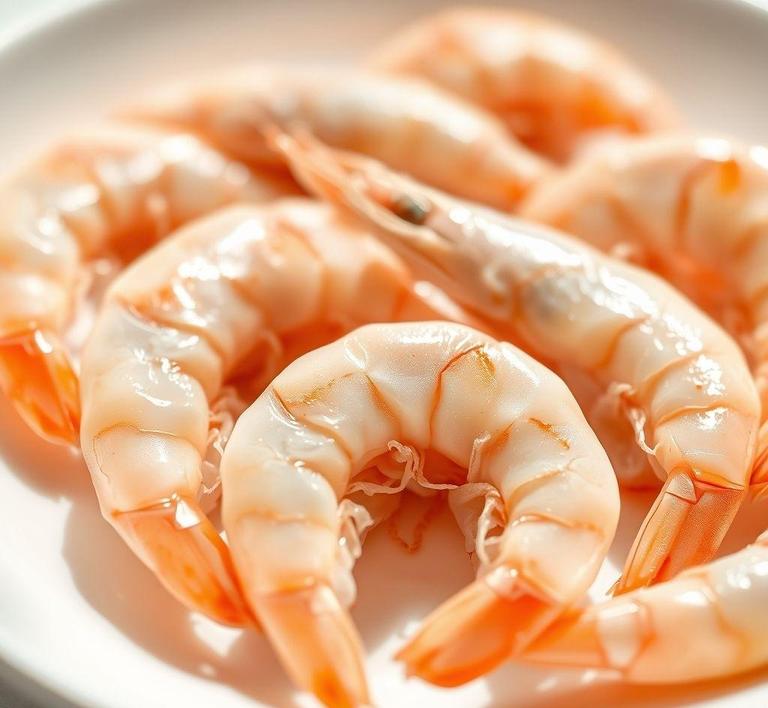Wondering if you can refreeze uncooked shrimp? You’re not alone! It’s a common question in the kitchen, especially when you buy too much or just can’t use them in time. While freezing shrimp is a great way to preserve them, the rules around refreezing can be a bit tricky. Refreezing uncooked shrimp isn’t always recommended, but it can be done if handled properly. From ensuring they stay at the right temperature to understanding the impact on texture and flavor, this guide will walk you through everything you need to know to safely refreeze uncooked shrimp without compromising quality.
Can You Refreeze Uncooked Shrimp?

When it comes to seafood, few things are as delicate and perishable as shrimp. If you’ve ever wondered whether it’s safe to refreeze uncooked shrimp, you’re not alone. Seafood enthusiasts and home cooks alike often face the dilemma of whether or not to freeze shrimp after it’s been thawed. The simple answer is yes, you can refreeze uncooked shrimp, but with important caveats. Refreezing uncooked shrimp can be done safely under certain conditions, but it’s crucial to understand the risks associated with it, particularly when it comes to texture, flavor, and overall quality.
Freezing shrimp works by halting bacterial growth and preserving the shrimp’s freshness. However, when shrimp is thawed, the quality begins to deteriorate. Refreezing doesn’t restart the clock; rather, it can continue the degradation process, which is why it’s important to be mindful of how and when you refreeze uncooked shrimp. It’s generally best to only refreeze shrimp once to prevent overexposure to bacteria, but more importantly, to maintain that desirable texture and flavor.
How To Refreeze Uncooked Shrimp?
Refreezing uncooked shrimp can be a straightforward process if done correctly. Here are the steps to ensure the shrimp remains as fresh as possible when refrozen:
-
Ensure the Shrimp Is Completely Thawed
Before refreezing, make sure that the shrimp is entirely thawed. This will help prevent ice crystals from forming within the flesh, which can cause cell damage. If you’ve already thawed shrimp in the refrigerator (which is the safest method), this step is easy. However, if you’ve used the microwave or left the shrimp at room temperature to thaw, make sure that it’s not in the ‘danger zone’ (temperatures between 40°F and 140°F) for too long, as bacteria can grow quickly at these temperatures.
-
Drain Excess Moisture
Shrimp releases water when it thaws, and excess moisture can lead to freezer burn and affect the texture of the shrimp when you cook it later. Gently pat the shrimp dry with paper towels or a clean kitchen cloth to remove as much moisture as possible. The drier the shrimp before freezing, the better the final outcome.
-
Use Proper Packaging
Packaging is crucial when refreezing uncooked shrimp. If you use improper packaging, your shrimp may get freezer burn, which will degrade the texture and flavor. Place the shrimp in an airtight plastic bag or vacuum-sealed bag, ensuring you remove as much air as possible. Alternatively, you can store the shrimp in an airtight container, but the bag option is often more effective at preventing air exposure.
-
Label and Date the Package
Always label your shrimp package with the date you’re refreezing it. It helps you keep track of how long the shrimp has been frozen. While shrimp can be safely stored in the freezer for up to 6 months, its quality will begin to decline over time. A simple label ensures that you don’t forget about your shrimp, and you can monitor its condition before cooking it.
-
Freeze Immediately
Once your shrimp is properly packaged and labeled, place it in the coldest part of your freezer as soon as possible. The faster you freeze it, the better its texture and flavor will hold up when you thaw it again. Avoid placing the shrimp in the freezer door, as the temperature can fluctuate more in these areas.
Quality Impact
The quality of uncooked shrimp will inevitably be impacted when you refreeze it. While it remains safe to eat as long as it has been handled and stored properly, refreezing can significantly alter the texture and taste. Let’s break down what to expect:
-
Texture Changes
One of the most noticeable effects of refreezing uncooked shrimp is a change in texture. Shrimp is naturally delicate, and freezing causes ice crystals to form inside the shrimp cells. These crystals rupture the cell walls, leading to a mushier or chewier texture upon thawing. Each time shrimp is frozen and thawed, the integrity of its flesh can suffer. When refrozen, it’s likely that the shrimp will lose some of its natural snap and firm texture, resulting in a slightly rubbery consistency when cooked.
-
Flavor Deterioration
Flavor is another area that suffers when shrimp is refrozen. The initial freeze locks in the shrimp’s natural flavors, but thawing and refreezing cause a slight loss of those fresh, briny notes. The shrimp may taste more bland or slightly “off”, especially if it has been stored in the freezer for too long. Additionally, the longer shrimp stays frozen, the more it can absorb odors from other foods in the freezer, which can further alter its taste.
-
Risk of Freezer Burn
Even with airtight packaging, there’s always a risk of freezer burn when freezing shrimp for extended periods. Freezer burn occurs when moisture evaporates from the surface of the shrimp, leading to dehydration and discoloration. While freezer-burned shrimp is safe to eat, it will likely have an unpleasant dry texture and taste. To minimize the risk of freezer burn, ensure your packaging is as air-tight as possible and that the shrimp is consumed relatively soon after refreezing.
-
Bacterial Growth
Bacteria multiply rapidly at temperatures between 40°F and 140°F, so it’s important to refreeze shrimp only if it has been thawed in the fridge. Shrimp thawed at room temperature or in warm water should not be refrozen, as doing so can promote bacterial growth. It’s essential to observe proper thawing and handling practices to keep the shrimp safe to eat.
While refreezing uncooked shrimp is possible, it’s not always the best choice if you want to preserve its freshness, texture, and flavor. The process of freezing, thawing, and refreezing shrimp will inevitably lead to some loss of quality. If you decide to refreeze uncooked shrimp, be mindful of the thawing process, proper packaging, and storage. Freezing shrimp that has been properly handled will minimize risks and allow you to enjoy your shrimp later without too much compromise on its quality.
However, if you value the freshest, best-textured shrimp, it’s advisable to avoid refreezing unless absolutely necessary. It’s also important to note that refrozen shrimp should be cooked thoroughly before consumption, as it has been through additional temperature fluctuations. For the best results, always use shrimp soon after purchasing or thawing, and if you do need to refreeze, take steps to ensure that it’s done safely and carefully.
Is It Safe To Refreeze Uncooked Shrimp?
The safety of refreezing uncooked shrimp is a topic that often stirs up questions, and with good reason. In general, it is not recommended to refreeze uncooked shrimp. Once shrimp are thawed, they go through a period of microbial growth. The longer shrimp sit at temperatures between 40°F (4°C) and 140°F (60°C), the greater the risk of harmful bacteria developing. Freezing helps to slow down the growth of bacteria, but it doesn’t necessarily kill all the microorganisms present.
When you thaw shrimp and then refreeze them, you’re essentially giving any bacteria that may have started to grow another chance to multiply. Freezing and thawing multiple times can also degrade the texture, making the shrimp mushy or rubbery, and ultimately affect their overall flavor and quality.
However, if the shrimp were thawed under controlled conditions-such as in the fridge or via the cold-water method-and if they haven’t been sitting out at room temperature for too long, it’s less risky to refreeze them. That said, you should still exercise caution and follow some guidelines to ensure the shrimp remain as safe and fresh as possible.
Signs That Uncooked Shrimp Should Not Be Refrozen
It’s important to understand the signs that indicate shrimp should not be refrozen. These visual and sensory cues will help you avoid consuming potentially harmful or spoiled seafood:
- Off-putting Smell: Fresh shrimp should have a mild, briny, or oceanic scent. If the shrimp smells sour, ammonia-like, or rancid, this is a clear indication that they’ve gone bad. The ammonia odor, in particular, is a sign of bacterial growth, which can be harmful if consumed.
- Slimy Texture: Fresh shrimp should have a firm, slightly moist texture. If the shrimp feels slimy, sticky, or overly soft to the touch, it’s a sign that they’ve begun to deteriorate and shouldn’t be refrozen.
- Color Changes: Uncooked shrimp that have started to spoil may have a faded or discolored appearance. Fresh shrimp should have a translucent or slightly opaque, grayish color. If they appear yellowish, blackened, or have dark spots or patches, it’s a sign that the shrimp is past its prime and could be unsafe to eat.
- Loose Shells: The shells of fresh shrimp should be intact and adhere tightly to the flesh. If the shells are cracked or loose, this may indicate that the shrimp has started to break down, which can be a sign of spoilage.
- Unusually Soft or Mushy Flesh: If the flesh of the shrimp is mushy or has become too soft upon thawing, this indicates that it’s not fresh anymore. This softness means the shrimp’s cell structure has been compromised, often due to extended exposure to warmer temperatures.
Common Refreezing Mistakes
While refreezing shrimp is generally not recommended, there are some common mistakes people make that could either reduce the risk of harm or make things worse. Here are a few to watch out for:
- Thawing Shrimp at Room Temperature: One of the biggest mistakes is leaving shrimp out at room temperature to thaw. Doing so creates the perfect breeding ground for bacteria, as temperatures between 40°F and 140°F are known to encourage bacterial growth. Always thaw shrimp in the refrigerator or in a bowl of cold water if you plan to refreeze them.
- Repeated Freezing and Thawing: Constantly refreezing and thawing shrimp is a surefire way to degrade both the quality and safety of the shrimp. Each cycle of freezing and thawing causes ice crystals to form and break apart the shrimp’s cellular structure, making them watery, mushy, and bland. It also increases the risk of bacterial growth each time the shrimp reach temperatures where bacteria can thrive.
- Improper Packaging: If you plan to refreeze shrimp, it’s important to package them properly. Shrimp should be tightly wrapped in plastic or placed in a vacuum-sealed bag to prevent freezer burn and dehydration. Simply tossing them back into the original packaging may expose them to air, which can diminish quality and taste.
- Not Checking the Temperature: Another mistake is not paying attention to the temperature of the shrimp before freezing them. Shrimp that have been sitting at room temperature for more than a couple of hours should not be refrozen. The USDA recommends that food should never be left out for more than two hours at temperatures above 40°F. If shrimp are left out too long, bacteria may already have begun multiplying, and refreezing won’t make them safe.
- Freezing Shrimp with the Shell On: Many people make the mistake of freezing shrimp with the shells still on. While this is fine for long-term freezing, it can cause issues when you thaw and refreeze them. The shells can trap moisture, leading to a mushy texture once the shrimp are thawed again. It’s better to peel the shrimp before freezing to maintain texture and quality.
Tips And Tricks
If you must refreeze shrimp, there are a few tips and tricks that can help mitigate risks and improve the outcome:
- Thaw Slowly in the Fridge: Always thaw shrimp in the refrigerator to ensure that they stay at a safe temperature. The gradual thawing process prevents bacteria from growing quickly. Ideally, allow the shrimp to thaw for 12-24 hours, depending on the size and amount.
- Use a Vacuum Sealer: A vacuum-sealed bag is the best way to store shrimp in the freezer. This method removes air and prevents freezer burn, which can dry out and deteriorate the shrimp’s texture. If you don’t have a vacuum sealer, try to remove as much air as possible using resealable freezer bags.
- Freeze Shrimp Immediately After Purchase: If you buy shrimp and don’t plan to cook it immediately, freeze it as soon as you get home. If you thaw it first and then decide not to cook it, freezing it again should only be done if it was never exposed to higher temperatures or left out for too long.
- Portion Control: If you’re unsure how much shrimp you’ll use in one sitting, consider portioning the shrimp before freezing. This prevents you from needing to refreeze the entire batch, reducing the risk of spoilage. You can easily defrost only the amount you need and leave the rest frozen.
- Use Shrimp within a Month: Even when frozen properly, shrimp can lose quality over time. For the best taste and texture, try to use frozen shrimp within one to two months. The longer it’s frozen, the more likely it will become tough and less flavorful.
- Be Mindful of Thawing Methods: If you must thaw shrimp quickly, place them in a sealed bag and immerse them in cold water. Never use hot water to thaw shrimp, as it can encourage bacteria growth. Quick-thawing methods that use cold water will prevent the shrimp from reaching the “danger zone” for bacterial growth.
Conclusion
While refreezing uncooked shrimp isn’t ideal, there are certain circumstances under which it can be done safely. The key is to pay close attention to how the shrimp were thawed, how long they’ve been sitting at room temperature, and whether there are any signs of spoilage. If the shrimp look, smell, or feel off, it’s always safer to discard them rather than risk foodborne illness. By following the proper techniques for thawing, packaging, and freezing shrimp, you can preserve their quality and reduce the likelihood of making common mistakes that could lead to food safety issues. When in doubt, it’s always better to err on the side of caution and enjoy shrimp that’s fresh and safely prepared.


